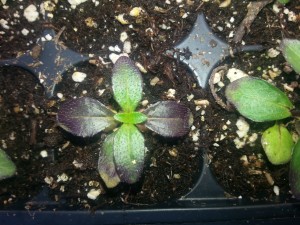Bedding plant growers have to get the jump on spring so their plants are flowering and gorgeous when we’re ready to start planting. They might start planting in February when even the greenhouses are a little cold. And sometimes those new leaves come out purple instead of green. You might be great fan of the color purple — but for healthy, quick-growing bedding plants? We want the leaves to be green.

Purplish leaves often indicate a phosphorus deficiency. Phosphorus is important to plants for root development and growth. But these plants are watered with fertilizer, so what’s going on? Cool gray weather, even when the plants are in a greenhouse, means plants grow more slowly — and they take up less water. Nor does the soil dry out as fast. Meaning — they need less watering. A cycle that brings us right back to fertilizer! Plant roots take up nutrients with the water. So even though the nutrients are in the soil, the roots aren’t pulling them in. Those plants are hungry!
Some growers use bottom heat from heat mats or systems that run under the benches to keep the roots warm even when air temperatures are low. Warmer roots drink up that water and nutrient cocktail — and have no deficiency symptoms.
What to do if you have purple petunia leaves? Warm them up, give them some extra phosphorus — and the new leaves will be bright green. Which saves the purple for the petals.
Learn more about nutrient deficiencies in petunia.